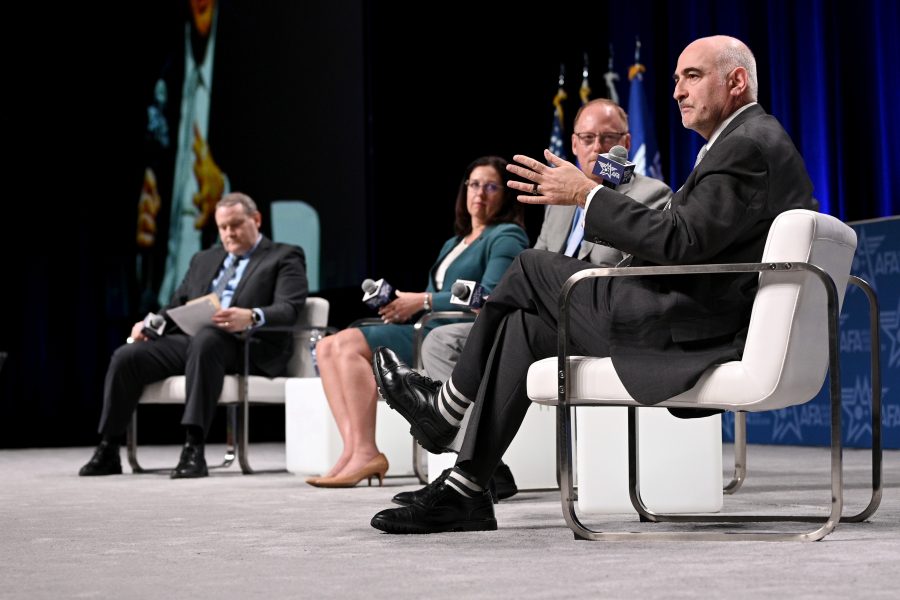RESTON, Va.—For all of its brief existence, the Space Force has enjoyed sizable budget boosts every year as the service grew, expanded, and took on new missions.
But with Congress struggling to pass a 2024 budget five months into the fiscal year, the threat of sequestration cuts kicking in after April 30, and spending caps set for fiscal 2025 under the Fiscal Responsibility Act, Space Force leaders warned at the National Security Space Association conference that hard decisions lay ahead.
“It’s just horrible, quite honestly,” said Frank Calvelli, the assistant secretary of the Air Force for space acquisition and integration, said of the budget uncertainty.
Lawmakers have until March 8 to avert a full government shutdown, and after the top Republicans and Democrats from the House and Senate met with President Joe Biden at the White House on Feb. 27, all indications are that they will need to pass yet another continuing resolution to keep the government open.
Some legislators have even pressed the idea of committing to a full-year CR, which would keep funding levels frozen at the 2023 level and generally prevent new programs from starting.
For a new service like the Space Force, the effects would be “crippling,” “frustrating,” and “devastating,” its leaders said.
Under the Fiscal Responsibility Act passed last summer, if any part of the government is still funded by a CR come April 30, the entire government will face a one percent budget reduction. For the Department of the Air Force, going from its requested 2024 budget to 2023 spending levels minus one percent would represent a “buying power reduction of $13 billion,” acting undersecretary of the Air Force Kristyn E. Jones said.
Even if Congress undid the sequestration provision, a year-long CR “would cancel $2.8 billion in Space Force R&D growth, about 10 percent of the entire Space Force budget,” Jones added. “It would undo effects for critical space architecture, including space data transport, missile warning/missile tracking, and [precision navigation and timing]. We would lose ground on the development of survivable, long-range persistent sensors and kill chain automation tools.”
For the Space Development Agency, which is built on the idea of going from contract award to launch in three years or less, the ongoing use of CRs is already having an impact, said director Derek M. Tournear.
“We have two acquisitions that are currently on hold pending appropriations,” Tournear said. “The FOO Fighter solicitation, which are new demonstration satellites for advanced fire control, those are eight satellites—we’re in source selection, we’re almost done source selection, but we certainly can’t write those contracts until we have a 2024 budget.”
Also stymied are the agency’s Tranche 2 Transport Layer gamma satellites, 20 in total. “We will not go out with that solicitation until we have an FY24 budget,” Tournear said. “So these are actual acquisition timelines that are being impacted today.”
If the use of CRs drags into April, it could start to threaten other efforts in SDA’s constellation of low-Earth orbit satellites, he added.
“At that point, we will have to work with our vendors because we won’t be able to continue paying them, and we’ll have to figure out what that means at that point,” Tournear said.
Calvelli added that a year-long CR would effectively stop work on Tranche 2 of the constellation.
On top of that, Calvelli noted that he would also be limited to buying three National Security Space Launch flights—a sharp reduction from the 10 planned in the budget. It would also frustrate efforts by the Space Force to work with the National Reconnaissance Office on their plans to develop and buy targeting satellites, he said.
As the uncertainty persists, the likelihood grows that the White House and the Pentagon will have to roll out their 2025 budget request on March 11 before the 2024 budget is in place—an awkward state of affairs that could force the Air Force and other military departments to reconsider their approach to the progress.
“Given the fact that we still don’t have ’24 and many of our investments in ’25 were based on having received those funds in ’24 and building on that momentum, we may ultimately, depending on how long this takes, have to revisit some of our strategies,” Jones said.
That’s on top of the fact that the Fiscal Responsibility Act has already set spending limits for 2025—just one percent growth over the limits set for 2024. The Space Force’s previous budget requests all had double-digit increases.
“Given the FRA caps, it is challenging this year and in particular for space,” said Jones. “We were given direction across the department that we needed to focus on our near-term readiness and the capabilities that would be fielded soonest. And that required us to take some risks in some of the things that we really need to do for the future, but we weren’t able to do.”
Jones warned of “significant impacts” for the service’s long-term plans, and the Space Force’s chief operations officer, Lt. Gen. DeAnna M. Burt, offered a hint of the impacts when asked for her message to industry.
“We need you to deliver the amazing capabilities over the years that you’ve delivered,” Burt said. “They can’t come as slow and they can’t be late or so over budget, based on the fiscal realities we’re dealing with.”

